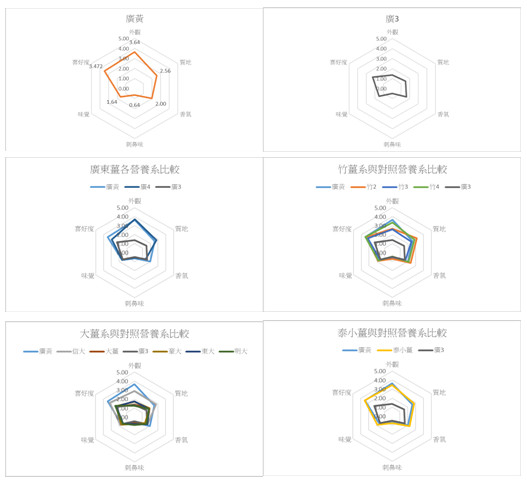- Demonstration of Multiple Recycling of Mushroom Materials to Drive Sustainable Production
- Optimization and Diffusion of Onion Healthy Seedling and Tomato Cultivation Adjustment Technology
- Establishment of Seed and Seedling Carbon Footprint Product Category Rules (PCR) Assessment
- Promoting to Popular Application of Intelligent Production and Sales Management in Vegetable Nurseries
- Research on Propagation Technology of Indigenous Taro Seedlings
- The Promotion of Conservation systems and the assessment of applications for indigenous heirloom foxtail millet(Setaria italia)
- Establishment and Verification of the Optimal Irrigation Mode for Melon in Protected Facility
- Counseling on Digital Transformation of Small,Medium and Micro-sized
- Establishment of Important Virus Detection Method for Grape in Taiwan
- Restablishment of Domestic Seed Corn and Sorghum Production System
- Construction of Environmental Verification System and Standards for Cucurbits Nurseries
- Promotion of Crop Healthy Germplasm Conservation and Propagation System
- Research on the New Development Trend of Seed Treatment Technology
- Study on Condition of Seed Storage for Food Crops
- Study on Tomato Rootstock Resistance to Bacterial Wilt and Implementation of Field Management Strategies in Seedling Nurseries
- Development and Application of Molecular Markers Associated with Anti-fusarium Wilt on Luffa and Drought-tolerance and Other Important Traits on Maize
- Analysis and application of root‐associated microbes from soil-borne disease resistant and sensitive lines of Solanaceae crops
- Development of Key Technologies for Tissue Culture-assisted Seed Selection
- Developing of crops novel assisted breeding technology on melon
- Research on germplasm maintenance and industrial application of vegetative propagation crops
- Germplasm Development and Application of Aeridinae Orchids and Cattleya Alliance.
- The Promotion of Aboriginal Beans Crops Seed Saving System
- Research on Genetic Resources and DUS Testing Techniques Management and Application for Economical and Special Crops
- Next-generation Ark of Agriculture and Forestry Germplasm - Germplasm Regeneration of Important Cross-Pollinated Crops.
- Construction of Certification System and Demonstration Field for Organic Rice and Upland Crop Seed
- Evaluation of soybean rotation model by organic cultivation management model.
- Techniques Development for Bulb Flowers Breeding
- Establishment of the Heat-Resistant Selection Index and Breeding of Tomato
- High Quality and Stress Tolerance Breeding in Tomato.
- Establishing Cucurbitaceae Vegetables New Varieties of Heat Tolerance and Related Technology
- Breeding of New Papaya Variety for the International Industry
- A Study on the Well-being Benefits of Horticultural Therapy for Elderly Residents in the Central Region.
- Research on the Behavioral Intentions of Agricultural Social Responsibility
- Research on the Development and Application of Diverse Food and Agriculture Teaching Materials of Potato
- Nutritional Function Analysis and Processing Technique Optimization of Ginger
- Application Evaluation of Taro Diversified Processing Raw Materials
- Study of Inspection and Monitoring System for Gene-edited and Genetically Modified crops
- Enhancing the Connection and Participation with Seed Testing Technology Related International Organization
 Home > Achievement > 2024Research Project List > Nutritional Function Analysis and Processing Technique Optimization of Ginger Home > Achievement > 2024Research Project List > Nutritional Function Analysis and Processing Technique Optimization of Ginger |
Nutritional Function Analysis and Processing Technique Optimization of Ginger
This study aims to address the challenges faced by Taiwan's ginger industry by using tissue culture techniques to preserve and regenerate the plant traits of various domestic ginger varieties (lines), and cultivate them in a controlled environment with plastic bag cultivation. Through nutritional data analysis and flavor evaluation, the study compares the key components of different varieties (lines) and establishes a classification system for the functional properties of Taiwanese ginger, as well as a variety database. The results show that the ginger varieties on the market are mixed, and further clarification is needed. The evaluation results indicate that the general public prefers varieties with a plump appearance, citrus fragrance, and lighter color. The Guangdong ginger line performed better in appearance, while the Bamboo ginger line showed higher pungency, fragrance, and overall preference. The ginger varieties had a significant difference in gingerol content, with a variation of up to 5.7 times. Promoting varieties with higher gingerol content could be beneficial for functional foods or pharmaceutical raw materials. Furthermore, during the essential oil extraction process, significant differences were observed in the quality and quantity of oils extracted from different nutritional lines, with some oils showing cloudy colors and poor odor, which could serve as a reference for improving raw material quality. Analysis of total volatile components revealed that ginger with lighter flesh color predominantly contained citronellal, while darker-colored ginger varieties had more abundant volatile compounds. Although the flavor of dark-colored ginger was not as favorable, it generally exhibited stronger disease resistance, and further antioxidant or disease resistance tests may uncover other functional components.
 ▲Fig. 1. Comparison of rhizome appearances among different ginger cultivated under identical conditions in terms of cultivation sites, substrates, managements, and harvesting times. |
|
|
 ▲Fig. 3. Comparison of key gingerol components in young and mature rhizomes across different ginger cultivars: Among all cultivars, 6-gingerol constitutes the highest proportion of gingerols. |
 ▲Fig. 4. Comparison of major volatile components among different ginger cultivars: The primary volatile components include citral, neral, camphene, eucalyptol, β-phellandrene, α-pinene, and zingiberene. |

